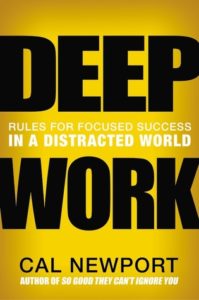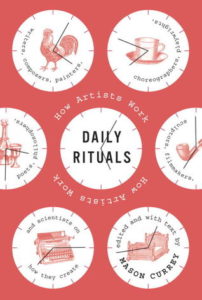For January, Anne Bogel chose Deep Work for the main pick with Daily Rituals for the flight pick. I have to admit—I DNF’d Daily Rituals, though I got more out of Deep Work than I originally expected.
Deep Work
I have a bit of a bias against self-help books or books that even seem like they might be in a category at the bookstore next to self-help books. There’s not a particularly good reason for this aversion and it’s probably got roots in my aversion of books one can find on the shelves at Lifeway but it is what it is. But gosh darn it, I pay a (well-earned, well-deserved) fee for this Book Club so I’m going to read the dang book. And I’m glad I did—I’ve implemented several of the suggestions in Deep Work to start off the year feeling more productive and less stressed at work.
 First, Newport defines “Deep Work” as “professional activities performed in a state of distraction free concentration that push your cognitive capabilities to their limit. These efforts create new value, improve your skill, and are hard to replicate.” Shallow Work is, essentially, everything else—it is the easily replicable things that suck time not brainpower but do not contribute significantly to the furtherance of any goals. What follows after this set up is a series of rules/proposals/examples that show why arranging your time and focus to provide solid blocks of time for Deep Work is vital to maximizing your working potential.
First, Newport defines “Deep Work” as “professional activities performed in a state of distraction free concentration that push your cognitive capabilities to their limit. These efforts create new value, improve your skill, and are hard to replicate.” Shallow Work is, essentially, everything else—it is the easily replicable things that suck time not brainpower but do not contribute significantly to the furtherance of any goals. What follows after this set up is a series of rules/proposals/examples that show why arranging your time and focus to provide solid blocks of time for Deep Work is vital to maximizing your working potential.
As an attorney and supervisor of advocates at a non-profit, much of what I do doesn’t fall neatly into the Deep Work-Shallow Work dichotomy Newport sets up—I wouldn’t call editing complaints and appeals by advocates to regulatory agencies “shallow work”—It’s a skill that took years to hone and develop to know the laws and rules, the players, the right tone, the arguments to make, even how to edit in a way that leaves the original writer’s voice and in a way they learn to adopt the changes I’m making into their future drafts to be better writers. It’s a skill I’m constantly improving at myself. It is Deep Work at the time its being done but it is rarely, if ever, Deep Work that requires me to think deeply more than 45 minutes before the entire appeal/project is done, so thinking about it later or when idle isn’t really an issue. Moreover, the suggestion seems to be that Shallow Work is a necessary evil that should be minimized. I would say, however, that one of the areas I’ve had to grow in most as a manager are the soft skills—for example, being supportive and interested in my supervisees’ lives so that they feel valued. I do value the people I work with and so need to make sure I’m taking the time to communicate this—all of this time, however, would be something Newport calls Shallow Work. (Though even he uses being a better mentor and supervisor as an example of a goal. I do not think then, that Newport would suggest that we all be automatons. I think this is another example where something perhaps doesn’t fit neatly into one of the two boxes.)
Even though I don’t think the dichotomy proves a perfect fit for my work, there are strategies that Newport suggested that have made the beginning of my work year more productive and less stressful. First, I’ve changed how I used my time. I moved my regularly scheduled check-ins where I review cases and new records with my supervisees to be at the beginning of the morning or afternoon, leaving larger chunks of time available for me to get into a project. This way I’m not working on something for an hour, interrupted for an hour, and then trying to get back in where I left off. I also got an hour-by-hour planner so I can log ahead of time how I want to use my day, though I use pencil so that I can adjust based on my actual use of time (since someone’s always having an emergency that needs to become my emergency). Planning how to use my time to complete various projects has made deadlines feel less stressful so that I feel I can leave work at work, while charting how I’m actually using my time has made me better aware of where I was wasting time (so I stop—no one really wants to write “Fifteen minute Instagram break” on their planner).
Newport also emphasizes taking time to figure out what your goals are—what really matters to you both professionally and personally—and fitting your time and your use of technology (Facebook is, as expected, pretty maligned) around activities that help you maximize your goals in a way that preserves idle time. Indeed, one of Newport’s main arguments it that idle time is necessary to allow the brain to rest, reset, and thus have the capacity to do tomorrow’s Deep Work. I found this section valuable and do want to take more time to really sit with the suggestions and questions he sets out here.
My only complaint is that Deep Work has a pretty serious gender bias in the quotes, examples, and studies cited. Women were given as examples or sources of material fifteen times to men’s one hundred examples. We could certainly parse this out further—men have published more studies than women have so there were more source materials for him to cite for men. Which is, of course, indicative of a larger problem within academia of not-supporting, not-publishing women. Even as this improves, women still have a hell of a way to go before the rates are the same. So perhaps—perhaps—it is unreasonable to suggest that the rate could have been fifty-fifty. But certainly Newport could have done a better job finding studies and examples such that I wasn’t left with an overwhelming sense that I was reading a book about men by a man. Something more than thirteen percent representation cannot have been that hard to achieve.
Daily Rituals
The flight pick was, in essence, examples of how various artists and thinkers organized their days to accomplish their Deep Work. I can see why Daily Rituals was a successful and entertaining blog concept—the descriptions of how various thinkers and artists spent their time is fascinating in the micro but gets repetitive in the macro. If I were to get one summary once a day (or even only a few times a week), I’d probably read them. But to try to get through 234 in the time I had the library book meant reading ten or more a day. The stories blended and I realized I was reading without any real comprehension or appreciation. I made it through 124 out of 234 before I called it quits and the only thing I can tell you is that Patricia Highsmith apparently smuggled in snails by hiding them under her breasts, six at a time, as she was crossing through customs when she moved to France. Also, I thought I wanted to read Look Homeward Angel, but now I’m not sure I can since I know way more than I ever wanted to know about Thomas Wolfe’s masturbation habits. (Which is to say, knowing any specifics at all is more than I want to know about anyone’s habits in that department. Knock yourself out but don’t tell me about it, please.)
 Another issue I had with this read that contributed to the running-together-problem was that there was almost no context given for who the person was that was being described. Sure, some (like Freud or Benjamin Franklin) didn’t need an introduction, but the guy who I think I figured out was a Russian choreographer definitely did. Even if I’d heard a name before, I couldn’t tell you why I knew them or what their body of work was. Not recognizing the subject of the essay contributed to the disconnect and kept me in skim-only mode.
Another issue I had with this read that contributed to the running-together-problem was that there was almost no context given for who the person was that was being described. Sure, some (like Freud or Benjamin Franklin) didn’t need an introduction, but the guy who I think I figured out was a Russian choreographer definitely did. Even if I’d heard a name before, I couldn’t tell you why I knew them or what their body of work was. Not recognizing the subject of the essay contributed to the disconnect and kept me in skim-only mode.
Finally, as with Deep Work, the subjects were overwhelmingly male and white and included Woody Allen. Going by my own quick count, there were 25 women to 135 men, meaning only 15.5% of the subjects were female. And while I didn’t count (since there were not pictures and I’d have had to google 234 people to confirm), I feel pretty solid in my assessment that the percentage of subjects of color is even less.
I did see how Daily Rituals connected to Deep Work and I could see how, in many ways, the assertions Newport makes in Deep Work played out—most artists/thinkers were only able to work for periods up to three hours before needing a break. Some managed to be creative or prolific in their fields without having the kind of schedule Newport suggests, though I could see how it was certainly more difficult for them to do so.
Overall, I see why the book was picked for the flight, but don’t feel bad about abandoning it. When I look back at my notes, the themes I was picking up seemed to be—“You get to sleep more than I do” or “Wow you do a lot of drugs.” Make of that what you will.

